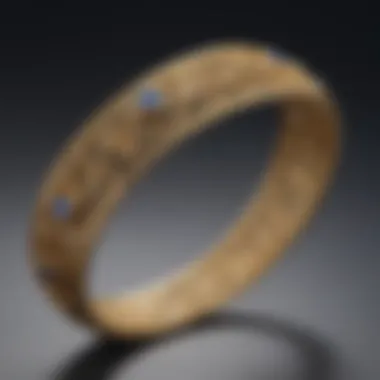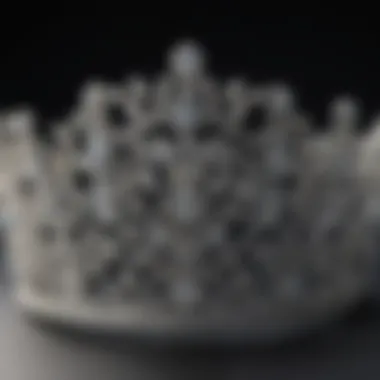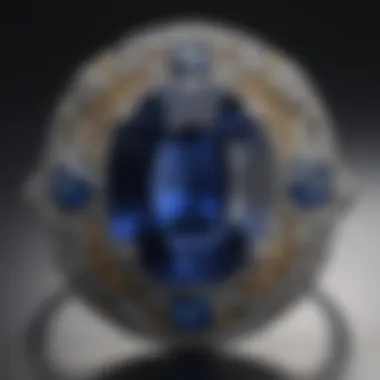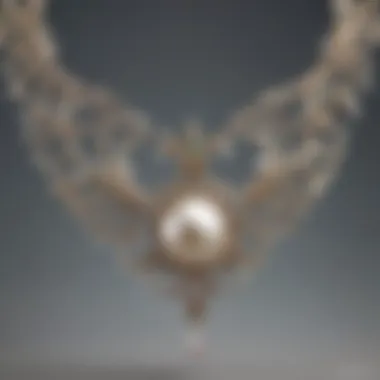Unveiling the Enchanting Aura of Vintage Jewelry Masterpieces


Overview of Gemstones and Minerals
Deep dive into the captivating realm of past times jewelry unravels a rich tapestry of gemstones and minerals. Throughout history, these precious natural elements have played a pivotal role in adorning and enriching human lives. From ancient civilizations to modern societies, gemstones and minerals hold a significant place in cultural expression and societal hierarchy.
Historically, gemstones and minerals have been revered for their symbolism, rarity, and beauty. They have adorned royalty, warriors, and commoners alike, signifying wealth, power, and spiritual beliefs. The evolution of their use provides a fascinating insight into the changing tides of human civilization.
Gemstone Formation and Properties
The intricate process of gemstone formation involves a combination of geological processes spanning millions of years. From the intense heat and pressure deep within the Earth to the gradual crystallization and transformation, each gemstone carries within it a unique tale of creation.
Gemstones are defined by a set of properties that distinguish them from other minerals. These properties include color, hardness, refractive index, and luster, which collectively contribute to the gemstone's allure and value. Classification based on color, hardness, and luster further categorizes gemstones into distinct groups, each with its own characteristics and significance.
Types of Gemstones
The distinction between precious and semi-precious gemstones has long been a topic of debate and intrigue among gem enthusiasts. While historical definitions may vary, precious gemstones such as diamonds, rubies, sapphires, and emeralds are universally coveted for their rarity, brilliance, and durability.
In contrast, semi-precious gemstones encompass a wide range of colorful and ornamental stones that captivate with their vibrant hues and unique formations. From amethyst and turquoise to garnet and opal, the world of semi-precious gemstones offers a kaleidoscope of options for jewelry artisans and collectors.
Exotic and rare gemstones add a touch of mystique and exclusivity to the realm of gemology. With their limited availability and exceptional beauty, gemstones like alexandrite, tanzanite, and paraiba tourmaline command attention and admiration from connoisseurs around the globe.
Identifying and Evaluating Gemstones
The value of a gemstone is influenced by a myriad of factors, including color, clarity, cut, and carat weight. Gemstone identification requires a combination of scientific analysis and expertise, utilizing tools such as microscopes, refractometers, and spectroscopes to reveal the gem's true nature.
Various techniques, such as the observation of inclusions, specific gravity testing, and spectral analysis, aid in the accurate evaluation and classification of gemstones. Assessing a gemstone's quality involves a detailed examination of its overall appearance, brilliance, and transparency, allowing gem professionals to determine its market worth and desirability.
Caring for Gemstones
Proper care and maintenance are essential to preserving the beauty and longevity of gemstone jewelry. Cleaning gemstones requires gentle handling and the use of mild soaps and soft brushes to remove dirt and oils without causing damage to the stones.
Storing gemstones in separate compartments or soft pouches helps prevent scratches and chips, maintaining their pristine condition for years to come. Avoiding exposure to chemicals, extreme temperatures, and harsh impacts is crucial in safeguarding the integrity of gemstones, ensuring their enduring radiance and value.
Preservation tips tailored to specific gem types, such as emeralds, pearls, and tourmalines, offer valuable insights into preventing common issues like discoloration, loss of luster, and surface damages. By following these guidelines, gemstone enthusiasts can enjoy their treasures for generations, keeping these precious reminders of the past times' allure alive and vibrant.
Introduction
Embarking on a journey to delve deep into the mesmerizing realm of past times jewelry is akin to unlocking a treasure trove of history, artistry, and culture intricately woven into each exquisite piece. The allure of antique and vintage jewelry transcends mere adornment, offering a glimpse into the evolution of human craftsmanship and the expression of cultural identities across diverse eras. As we traverse through the annals of time, we are set to unravel the stories behind these ornate creations that have withstood the test of time.
In the forthcoming sections of this insightful narrative, we will navigate through the distinct epochs of jewelry-making, starting from the ancient civilizations' treasures that hold profound historical significance. Subsequently, we will explore the opulence of medieval jewelry adorned with gothic influences and symbolic motifs, followed by the revival of elegance in Renaissance jewelry marked by innovative gemstone settings and intricate designs. Transitioning towards the charisma of vintage pieces, we will bask in the Victorian era's sentimental jewels and popular gemstones, venture into the art deco movement's geometric patterns and colorful gemstone aesthetics, and indulge in the mid-century glamour influenced by Hollywood trends and bold, statement designs.
Moving forward to uncover hidden gems, we will shed light on forgotten techniques that are being revived to preserve artisanal skills, intricacies of rare gemstone finds that captivate collectors, and the contemporary approaches of repurposing and reinventing vintage jewelry to embody classic styles with a modern twist. Immerse yourself in the legacy preservation as we delve into museum collections showcasing iconic jewelry exhibits, educational initiatives aiming to train the next generation of jewelers and enhance jewelry history awareness, and ethical considerations promoting sustainable practices and ethical sourcing of precious gemstones ensuring the industry's integrity and longevity.


The Allure of Antique Jewelry
Antique jewelry holds a significant place in the realm of past times jewelry, symbolizing historical elegance and intricate craftsmanship. These exquisite pieces bear witness to bygone eras, reflecting the cultural heritage and artistic finesse of antiquity. The allure of antique jewelry lies in its ability to transcend time, captivating admirers with its unique designs and storytelling allure. Exploring the world of antique jewelry offers a profound connection to the past, unravelling tales of grandeur and sophistication.
Ancient Treasures
The Significance of Ancient Jewelry
Ancient jewelry carries immense historical significance, serving as cultural artifacts that provide insight into ancient civilizations. The use of diverse materials, such as gold, silver, and precious gemstones, showcases the craftsmanship and aesthetic sensibilities of ancient artisans. The significance of ancient jewelry lies in its dual role as adornment and symbolic representation, embodying beliefs, rituals, and societal hierarchies. With intricate designs and symbolism, ancient jewelry pieces narrate tales of tradition and legacy, making them sought-after treasures for collectors and historians alike.
Materials and Techniques Used in Ancient Times
The materials and techniques employed in ancient jewelry production exemplify the mastery and ingenuity of ancient craftsmen. From intricate filigree work to delicate granulation methods, ancient artisans utilized a variety of skills to create breathtaking pieces. Ancient jewelry primarily utilized natural materials like gemstones, pearls, and metals, showcasing a harmonious blend of nature's beauty and human artistry. The use of advanced techniques such as cloisonné enameling and repoussé demonstrated the advanced metallurgical knowledge possessed by ancient civilizations, setting a benchmark for craftsmanship that continues to inspire contemporary jewelry artists.
Medieval Marvels
Gothic Influences in Medieval Jewelry
Medieval jewelry, influenced by Gothic architecture and artistic movements, encapsulates a sense of romanticism and mystery. Gothic influences in medieval jewelry are characterized by intricate patterns, pointed arches, and religious motifs, reflecting the spiritual essence of the era. The use of dark gemstones like onyx and garnet adds a dramatic flair to Gothic jewelry, embodying themes of power and opulence. Preserving the medieval charm, modern interpretations of Gothic jewelry pay homage to the elegance and mystique of this darkly enchanting era.
Symbolism in Medieval Jewelry Designs
Symbolism plays a pivotal role in medieval jewelry designs, where each motif and gemstone carries profound meaning and significance. Medieval artisans imbued jewelry pieces with symbolic representations of love, faith, and loyalty, creating pieces with emotional depth and cultural resonance. Knotwork designs symbolize eternity and interconnectedness, while animal motifs like dragons and griffins symbolize strength and protection. The intricate symbolism in medieval jewelry designs adds layers of storytelling and intrigue, inviting wearers to connect with the rich tapestry of medieval beliefs and traditions.
Renaissance Revival
The Rebirth of Elegance: Renaissance Jewelry
Renaissance jewelry signifies a revival of artistic elegance and sophistication, drawing inspiration from classical motifs and ancient aesthetics. The Rebirth of Elegance in Renaissance jewelry is characterized by intricate detailing, colorful gemstones, and harmonious symmetry, reflecting a newfound appreciation for beauty and refinement. Renaissance jewelry pieces exude opulence and grandeur, combining artistic ingenuity with a sense of majesty. The revival of classical aesthetics in Renaissance jewelry marked a cultural reawakening, bringing forth a golden age of creativity and craftsmanship in the world of adornments.
Innovations in Gemstone Settings
Innovations in gemstone settings during the Renaissance period revolutionized the world of jewelry design, introducing new techniques and settings that enhanced the beauty of gemstones. From pavé settings to collet settings, Renaissance jewelry embraced versatility and creativity in showcasing gemstones. The use of intricate metalwork and elaborate settings allowed gemstones to shine in unique ways, enhancing their brilliance and allure. Innovations in gemstone settings not only showcased the mastery of Renaissance craftsmen but also laid the foundation for future innovations in jewelry design, offering endless possibilities for showcasing the beauty of precious stones.
The Charisma of Vintage Pieces
Antique jewelry holds a distinct allure, encapsulating a rich history of craftsmanship and artistry that transcends time. Vintage pieces offer a glimpse into bygone eras, each telling a unique story through intricate designs and exquisite gemstones. The charisma of vintage jewelry lies in its ability to connect us with the past, celebrating the skilled hands that crafted these treasures centuries ago. Exploring vintage pieces allows us to appreciate the evolution of jewelry styles and techniques, offering a deep dive into the cultural significance of adornment throughout history.
Victorian Opulence
Sentimental Jewelry of the Victorian Era
Sentimental Jewelry of the Victorian Era holds a special place in the realm of vintage pieces, embodying emotional connections and symbolisms within each intricate design. These pieces often feature motifs like hearts, flowers, and lockets, reflecting sentiments of love, loss, and remembrance. The ornate craftsmanship of Victorian sentimental jewelry exemplifies the attention to detail and sentimentality prized during this era, making them cherished heirlooms. While these pieces evoke nostalgia and tradition, they also showcase the technical prowess of Victorian jewelers, employing techniques like enamelwork and filigree to create enduring symbols of affection and memory.


Popular Gemstones in Victorian Jewelry
Victorian jewelry is renowned for its use of a wide array of gemstones, each imbued with meanings and characteristics that added depth to the jewelry pieces. Popular gemstones of the era include rich red rubies, deep blue sapphires, and vibrant emeralds, often set in ornate gold settings. These gemstones not only added color and vibrancy to Victorian jewelry but also carried symbolic significance, with each stone believed to convey different virtues or sentiments. The Victorians' love for gemstones extended to diamond accents, pearls, and intricate gemstone arrangements, showcasing the opulent aesthetic that defined this era of jewelry design.
Art Deco Elegance
The Influence of Art Deco Movement on Jewelry
The Art Deco movement revolutionized jewelry design, introducing bold geometric shapes, linear patterns, and vibrant color combinations that set it apart from previous eras. Art Deco jewelry exuded a sense of modernity and sophistication, drawing inspiration from contemporary art, architecture, and societal shifts. The streamlined aesthetic of Art Deco pieces reflects a departure from the ornate styles of the past, embracing a more minimalist yet impactful approach to adornment. The influence of the Art Deco movement on jewelry continues to resonate today, with its timeless elegance and avant-garde spirit captivating the hearts of collectors and enthusiasts worldwide.
Geometric Patterns and Colorful Gemstones
Geometric patterns and colorful gemstones lie at the core of Art Deco jewelry, each element meticulously selected to create striking visual compositions. From bold, angular shapes to intricate symmetry, Art Deco pieces celebrate the juxtaposition of form and color, resulting in visually dynamic and aesthetically pleasing designs. Gemstones such as onyx, lapis lazuli, and coral were popular choices for Art Deco jewelry, prized for their vivid hues and ability to complement the geometric motifs prevalent in this style. The use of gemstones in Art Deco pieces not only added a pop of color but also enhanced the overall visual impact, transforming each piece into a wearable work of art.
Mid-Century Glamour
Hollywood Influence on Jewelry Trends
The glitz and glamour of mid-century Hollywood played a significant role in shaping jewelry trends of the era, with movie stars and socialites setting the stage for bold, statement pieces. Influential figures like Audrey Hepburn and Marilyn Monroe popularized dazzling diamonds, oversized cocktail rings, and elaborate necklaces, elevating jewelry to a status symbol of luxury and sophistication. The Hollywood influence on jewelry trends brought forth a sense of escapism and extravagance, inspiring designers to create pieces that exuded drama and allure, capturing the essence of old-world glamour in every intricate detail.
Bold Designs and Cocktail Rings
Bold designs and cocktail rings epitomize the spirit of mid-century glamour, embodying a sense of confidence and glamour that defined the era. These pieces often featured oversized gemstones, intricate metalwork, and elaborate settings, designed to make a statement and command attention. Cocktail rings, in particular, became a symbol of sophistication and style, adorning the fingers of fashionable men and women at social gatherings and glamorous events. The boldness of mid-century jewelry design resonates with lovers of vintage pieces today, offering a glimpse into a time when excess and extravagance were celebrated in both fashion and adornment.
Uncovering Hidden Gems
When delving into the fascinating world of past times jewelry, the section on Uncovering Hidden Gems holds pivotal importance. This segment aims to shed light on the less-explored aspects of jewelry history, focusing on forgotten techniques, rare gemstone finds, and innovative ways of repurposing vintage pieces. By highlighting these hidden treasures, readers are offered a deeper insight into the rich tapestry of the jewelry world, unveiling nuances that may have been overlooked amidst more mainstream narratives.
Forgotten Techniques
Reviving Lost Artisanal Skills
In the realm of Reviving Lost Artisanal Skills, the emphasis is on reincarnating traditional craftsmanship that has been overshadowed by modern techniques. By reviving these time-honored practices, artisans can preserve cultural heritage while infusing new life into contemporary creations. The key characteristic of this approach lies in its ability to bridge the gap between past and present, offering a unique blend of historical reverence and visionary innovation. Choosing to revive lost artisanal skills within this article enriches the narrative by underlining the timeless essence of artisanal craftsmanship and its enduring relevance in a rapidly evolving industry.
Ancient Filigree and Granulation Methods
Within the domain of Ancient Filigree and Granulation Methods, the focus shifts to intricate detailing and elaborate ornamentation techniques that were prevalent in bygone eras. The key characteristic of these methods is their meticulous attention to detail, where tiny granules and delicate filigree work come together to form spellbinding patterns. By delving into the world of ancient filigree and granulation, readers gain a profound appreciation for the patience and precision required to execute these intricate designs. While these techniques exude a sense of timeless beauty, their disadvantages may lie in the labor-intensive nature of their execution, requiring a skilled hand and unwavering dedication to achieve perfection.
Rare Gemstone Finds
Exploring Uncommon Gem Varieties


Exploring Uncommon Gem Varieties introduces readers to the enchanting realm of rare and lesser-known gemstones that add a touch of exclusivity to jewelry pieces. The key characteristic of this exploration is the sense of discovery and uniqueness attached to these gems, offering a refreshing departure from mainstream choices. By venturing into uncharted territory, individuals can set their jewelry collection apart with these distinctive stones, showcasing a flair for individuality and discernment in gem selection. While the advantages of incorporating uncommon gem varieties include exclusivity and intrigue, one must navigate the challenge of limited availability and sourcing complexities.
Collector's Guide to Exceptional Gems
Turning the spotlight on the Collector's Guide to Exceptional Gems, this section acts as a beacon for enthusiasts seeking to expand their knowledge and appreciation of rare gemstones. The key characteristic here is the meticulous curation of information regarding exceptional gems, providing readers with valuable insights into rarity, quality, and market value. By offering a guide to discerning collectors, this segment equips individuals with the expertise needed to make informed decisions when acquiring precious gemstones. While the advantages of having a collector's guide include enhancing one's gemstone expertise and investment acumen, collectors may encounter challenges related to authentication and price volatility.
Repurposing and Reinventing
Upcycling Vintage Jewelry
The realm of Upcycling Vintage Jewelry offers a sustainable approach to reviving classic pieces by infusing them with contemporary charm. The key characteristic of upcycling lies in its ability to breathe new life into outdated or damaged jewelry, transforming them into statement pieces with a modern twist. By choosing to upcycle vintage jewelry, individuals align themselves with eco-conscious practices and the trend of sustainable fashion. This unique feature of repurposing not only reduces waste but also allows for the preservation of sentimental pieces, creating a meaningful connection between past and present.
Contemporary Interpretations of Classic Styles
Delving into Contemporary Interpretations of Classic Styles illuminates how traditional designs are reimagined to cater to modern tastes and preferences. The key characteristic here is the fusion of timeless elegance with contemporary flair, offering a fresh perspective on iconic motifs and styles. By exploring these reinterpretations, readers gain a broader understanding of the evolving nature of jewelry design, where heritage meets innovation. While the advantages of contemporary interpretations include versatility and relevance, individuals may need to navigate the fine line between homage to tradition and artistic experimentation for effective reinvention.
Preserving the Legacy
Exploring the world of past times jewelry delves deeper into the significance of preserving the legacy of these exquisite pieces that hold invaluable historical and cultural importance. Preserving the legacy not only ensures the survival of ancient techniques and craftsmanship but also honors the rich artistic heritage embedded in each vintage piece. By safeguarding these jewels, we maintain a connection to our past, allowing future generations to appreciate and learn from our ancestors' creativity and skills. The preservation of legacy jewelry serves as a testament to the enduring allure and timeless elegance of these artifacts, encapsulating a momentous epoch in the evolution of jewelry design and craftsmanship.
Museum Collections
Iconic Jewelry Exhibits
Iconic jewelry exhibits within museum collections offer a rare glimpse into the opulence and innovation of past eras, showcasing captivating pieces that have stood the test of time. These exhibits feature remarkable creations that highlight the mastery of ancient artisans, presenting intricate designs and exquisite detailing that embody the essence of bygone civilizations. The significance of these exhibits lies in their ability to educate and inspire future generations, serving as tangible links to history and culture. Iconic jewelry exhibits not only showcase the aesthetic beauty of these adornments but also symbolize cultural heritage and artistic evolution, shaping our understanding of the past and influencing contemporary design trends.
Conservation and Restoration Efforts
Furthermore, conservation efforts play a pivotal role in maintaining the integrity and longevity of museum collections, ensuring that these priceless jewelry pieces remain pristine for years to come. Restoration initiatives aim to revive faded glory, repair damage, and preserve the authenticity of historical artifacts, allowing modern audiences to experience the magnificence of past jewelry eras. Conservation practices encompass a range of meticulous techniques, including cleaning, stabilization, and documentation, all aimed at safeguarding the heritage and value of these irreplaceable treasures. By prioritizing conservation and restoration, museums not only protect their collections but also facilitate ongoing research, education, and appreciation of ancient jewelry artistry.
Educational Initiatives
Training the Next Generation of Jewelers
Educational initiatives focusing on training the next generation of jewelers play a vital role in preserving the legacy of past times jewelry, ensuring that traditional craftsmanship techniques are passed down through the ages. By imparting knowledge and practical skills to aspiring jewelers, these initiatives help sustain ancient jewelry-making traditions and promote a deep understanding of historical design methods. Training programs nurture creativity, technical proficiency, and cultural appreciation, empowering students to carry forward the legacy of past times jewelry and contribute to the continuity of artistic expression.
Promoting Jewelry History Awareness
Moreover, promoting jewelry history awareness through educational initiatives cultivates a broader understanding of the cultural significance and artistic value embedded in vintage adornments. By engaging with historical contexts, craftsmanship techniques, and design aesthetics, enthusiasts and scholars can gain deeper insights into the evolution of jewelry through different epochs. Building awareness about jewelry history not only enhances appreciation for past times jewelry but also fosters a sense of connection to the heritage and craftsmanship of earlier civilizations. Educational efforts in jewelry history advocacy play a crucial role in preserving the legacy of these timeless treasures and maintaining their relevance in contemporary society.
Ethical Considerations
Sustainable Practices in Jewelry Industry
Ethical considerations in the jewelry industry have gained prominence in recent years, with a growing focus on sustainable practices that prioritize environmental responsibility and ethical sourcing. Sustainable practices involve minimizing the environmental impact of jewelry production, promoting fair labor practices, and supporting ethically responsible sourcing of materials. By adopting sustainable measures, jewelers contribute to conservation efforts, reduce carbon footprint, and ensure the longevity of natural resources for future generations. Integrating sustainable practices into the jewelry industry not only aligns with ethical values but also resonates with consumers who seek transparency and accountability in their purchasing choices.
Ethical Sourcing of Gemstones
Ethical sourcing of gemstones is a critical aspect of preserving the legacy of past times jewelry, as it upholds ethical standards and promotes integrity within the industry. Ethical sourcing practices prioritize traceability, fair trade principles, and environmental sustainability in the extraction and processing of gemstones. By opting for ethically sourced gems, jewelers uphold human rights, support local communities, and combat exploitative mining practices. Ethical sourcing not only enhances the value and authenticity of jewelry pieces but also reinforces the ethical foundations of the jewelry trade, inspiring trust and confidence among consumers. Embracing ethical sourcing of gemstones underscores a commitment to upholding moral values and ensuring the enduring legacy of past times jewelry for generations to come.







